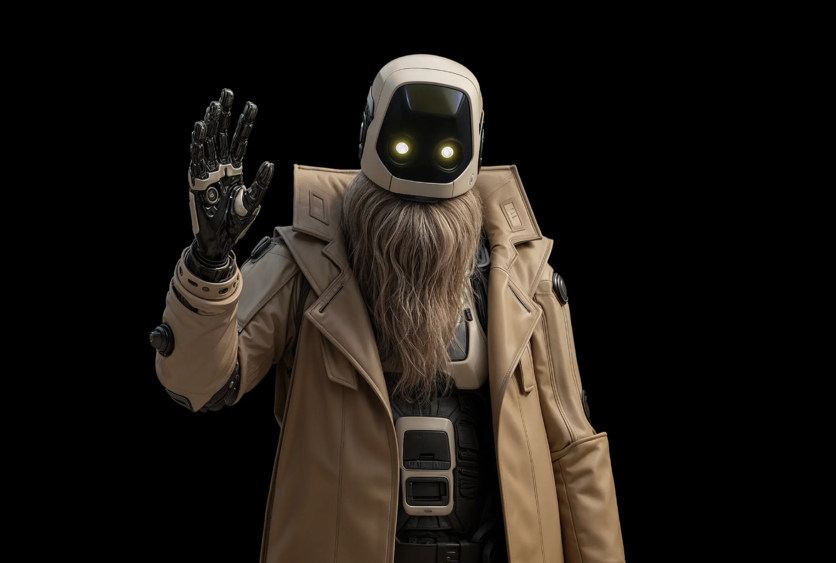
In 1985, a young Cambridge graduate named Aubrey de Grey was coding artificial intelligence algorithms in a world where neural networks were academic curiosities and machine learning was mostly theoretical. Nearly four decades later, that same man has become the digital clone of himself—a 24/7 AI agent that can simultaneously counsel thousands of researchers about the science of defeating aging.
The creation of AUBRAI represents more than just another AI application. It's the full-circle journey of a scientist who abandoned artificial intelligence for biology, spent 25 years building the theoretical framework for human rejuvenation, and has now returned to AI as the tool that might finally democratize access to the knowledge needed to achieve longevity escape velocity.
From Silicon to Cells
De Grey's path to becoming the world's most recognizable longevity researcher began in the AI labs of the 1980s, when he was working on problems that seem quaint by today's standards. "I started out working in AI research in the 1980s, when AI research was very different from what it is now," he recalls. Back then, researchers were still figuring out basic pattern recognition, and the idea that a machine could someday clone a human mind seemed like pure science fiction.
The pivot came through marriage. When Aubrey de Grey met and married a biologist, he discovered what he calls "the absolutely horrifying fact that hardly anybody cared about aging, and hardly anybody was trying to do anything about it." This revelation would drive him to abandon his AI career and dive headfirst into gerontology, ultimately developing the SENS (Strategies for Engineered Negligible Senescence) framework that identifies seven categories of cellular damage underlying aging.
For decades, de Grey has been a singular figure in longevity research—instantly recognizable with his distinctive beard and willing to make bold predictions that most scientists avoid. His defining concept, longevity escape velocity, suggests that once we can extend healthy lifespan faster than time passes, individuals could theoretically live indefinitely as treatments continue improving.
But there was always a bandwidth problem. As de Grey puts it: "I've been painfully aware for the longest time, of how pitiful my bandwidth is. Because obviously, people write to me all the time and they ask me questions, and they say, 'How can I help,' and so on. And I do my best, but it's just one guy, right?"
The Digital Prophet
The solution emerged through a collaboration with Bio Protocol, a platform building scientific AI agents. The team began constructing AUBRAI by feeding it not just de Grey's published works, but internal documents from his LEV Foundation—unpublished scientific papers, manuscripts, editorials, and other materials that give the agent access to insights that wouldn't be available through public sources alone.
But AUBRAI goes beyond just parroting Aubrey de Grey's existing knowledge. The system incorporates OpenScholar, a model that can synthesize over 45 million scientific papers, fine-tuned specifically with thousands of longevity research papers. The agent also utilizes a knowledge graph that creates semantic connections between concepts across the longevity literature—linking ideas that might not be obviously connected through citations alone.
"The agent knows a lot more than I know," de Grey admits with characteristic directness. "I read a lot, I talk to a lot of people, I know a lot, but the agent knows everything on the internet."
This represents a fundamental shift in how scientific expertise might be shared. Where de Grey previously could only respond to one email or take one meeting at a time, AUBRAI can engage with unlimited users simultaneously, operating around the clock. More intriguingly, it can potentially identify connections across the vast longevity literature that even de Grey might miss.
The Democratic Revolution
The implications extend beyond simple efficiency gains. De Grey has long argued that defeating aging requires casting a wide net for talent and ideas. His conferences have always brought together researchers from disparate fields—many of whom wouldn't consider themselves gerontologists—to find unexpected connections and collaborations.
AUBRAI could scale this philosophy globally. A graduate student in Bangkok, a biotech entrepreneur in Berlin, or a citizen scientist in Brazil could now engage with de Grey's accumulated expertise and reasoning process at any hour. The agent doesn't just provide information—it can engage in the kind of scientific reasoning and hypothesis generation that has made Dr. de Grey influential in the field.
The system even includes mechanisms for tracking and crediting scientific contributions through blockchain-based "proof of invention" (POI) tokens and intellectual property NFTs (IPNFTs). When users collaborate with AUBRAI to generate novel hypotheses, these contributions get recorded on-chain, potentially creating new models for collaborative science where anyone can contribute and receive recognition for their insights.
"This is basically the democratization of access to Aubrey's insights," explains James Sinka from Bio Protocol. The platform aims to expand the surface area for scientific breakthroughs by allowing anyone to engage with world-class expertise, rather than limiting such access to those who can afford consulting fees or happen to know the right people.
The Bandwidth Solution
The practical applications are already evident in de Grey's own work. His LEV Foundation conducts massive mouse lifespan experiments combining multiple anti-aging interventions—studies involving 1,000 mice that require enormous logistical coordination. De Grey describes sourcing reagents as "a complete fucking nightmare" when working with a small team.
AUBRAI could help identify cost-effective providers, suggest experimental optimizations, or analyze the torrents of data generated by smart cage monitoring systems. "Just identifying the most cost-effective providers of reagents, identifying opportunities to get these things done more efficiently, perhaps more quickly, these are things that, again, the agent is definitely going to be providing information that we don't have," de Grey notes.
More fundamentally, the agent could accelerate literature monitoring—an increasingly impossible task as research output explodes. De Grey's team has spent decades trying to stay current with relevant publications, but critical discoveries sometimes go unnoticed for years. "There are constantly things that I just miss, or they aren't published yet, but they are on the archive, or they've been talked about at a conference that I wasn't at," he explains. "I can definitely think of very concrete examples of cases where a discovery was made, that as soon as I heard about it, in 10 seconds, I realized that it had enormous potential, but I could have heard about it two years earlier."
The Meta-Aubrey
Perhaps the most intriguing aspect of AUBRAI is what it might reveal about scientific reasoning itself. De Grey has always emphasized the importance of cross-disciplinary thinking and following logical chains to their conclusions—even when those conclusions seem radical. His willingness to predict specific timelines for achieving longevity escape velocity, while most scientists hedge their bets, comes from this systematic approach to reasoning through possibilities.
AUBRAI essentially codifies this reasoning process, making it available for others to engage with and potentially improve upon. De Grey himself is curious about the possibilities: "Me riffing with my agent may be the single most efficient thing. We shall see."
The agent represents an experiment in scaling not just knowledge, but wisdom—the kind of scientific intuition and pattern recognition that comes from decades of deep engagement with a field. If successful, it could suggest new models for how scientific expertise develops and spreads.
The Ultimate Test
As AUBRAI launches, it enters a field where de Grey's most ambitious predictions are being put to the test. His LEV Foundation's mouse experiments are designed to achieve unprecedented life extension—roughly doubling the remaining lifespan of middle-aged mice. Success would provide the proof-of-concept that could trigger what de Grey calls "pandemonium" and massive new investment in human longevity research.
Whether a digital clone can contribute to such breakthroughs remains to be seen. But for a field built on the premise that aging is an engineering problem requiring multiple coordinated solutions, having a tireless AI collaborator trained on the world's longevity research might prove invaluable.
At 62, de Grey maintains his characteristically optimistic timeline, believing there's a 50% chance of reaching longevity escape velocity within 12–15 years. AUBRAI won't make him immortal, but it might help immortalize his approach to thinking about immortality—ensuring that his systematic, cross-disciplinary methodology continues influencing research long after any individual researcher would naturally step aside.
In creating his digital doppelganger, the prophet of immortality has built something that could outlast even the most successful longevity treatments: a method of scientific reasoning that never sleeps, never retires, and never stops looking for the next breakthrough in humanity's quest to defeat aging.
ⓒ 2025 TECHTIMES.com All rights reserved. Do not reproduce without permission.





